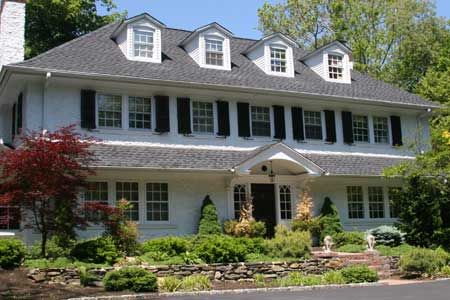
Think of American architecture in the 19th century and, most likely, Victorians of various shapes and styles come to mind. But while it was true that Sticks, Second Empires, and Queen Annes were popping up across the country, an inevitable change in taste began to develop on the East Coast in the 1870s. Whether it is seen as a stylistic backlash or as a more complex reaction to social trends and historic events, the Colonial Revival took hold quickly and became one of this country’s longest-lived architectural forms, with countless versions being built even today.
Architectural historians such as Vincent Scully describe a nostalgia for “the good old days” beginning to emerge in the mid-1800s. Books and articles appeared describing old ways and old days, especially those in seaside locations like Newport, Rhode Island, and Newburyport, Cape Ann, Cape Cod, Nantucket and Martha’s Vineyard in Massachusetts. Something about the simplicity and wholesomeness of earlier times down by the sea captured the imaginations of people feeling overwhelmed by their increasingly complex, industrialized world, with its crowded and unhealthy cities.
The approach of the country’s centennial did nothing to dampen this fascination with our past, and all things old and American took on a special glow. Some have suggested that part of this looking back to an idealized colonial past was fueled by Anglo-Saxon America’s growing unease with the waves of European immigrants hitting American shores, as well as the emancipation of this country’s slaves following the Civil War.
Whatever the reasons, the climate was right for a new style of architecture based on the perceived values and received forms of the colonial era. In 1874, an influential magazine published a photograph of a 1728 house in Newport, lamenting its advancing state of decay and advising that such houses should be preserved or at least recorded, as they were both picturesque and of “architectural merit.” In 1877, the prominent architects McKim, Mead, White and Bigelow took what they called their “celebrated” trip through New England, sketching and making measured drawings of “important colonial houses.”
It was not long before they and others were designing buildings of varying colonial veracity. At first, much of the new trend appeared as a decorative overlay on the current Queen Anne style — generous applications of neo-classical touches such as dentil mouldings, pediments, fluted columns and Palladian windows over the rather free-form and asymmetric underlying structures. Such was the appeal of the new look that some existing buildings were “done over” in the Colonial Revival style. Our own Wayland project house, built in 1815, was so treated in a major renovation in 1888; our Manchester house, originally an unadorned Shingle-style building from 1883, was extensively dressed up at the turn of the century with balusters, columned porches, decorative swags, and a huge pedimented entrance.
As architects delved deeper into the source material (i.e., real colonial homes), the style took on a more academic tone, becoming firmly aligned with the most academic of colonial styles, the Georgian. The result was Colonial Revival houses displaying the symmetry, formal detailing and proportions of their forebears.
By the turn of the 20th century, understanding of the colonial style spread across the country through books and periodicals featuring detailed measured drawings and photographs of colonial prototypes. In addition to the popular Georgian side-gabled versions, Colonial Revival houses quote other precedents, including the gambrel type favored by the Dutch settlers, hip-roofed Federals, and medieval-style examples with overhanging second floors (the inspiration for the garrison colonial of subdivision fame). They come in one, two or three stories.
Like their predecessors, Colonial Revivals of all stripes feature strong entrances and cornices, with double-hung windows featuring multiple panes. Due in part to matters of taste and to advances in woodworking technology, entrances tend to be more elaborate than the originals, with broken pediments common. Cornices feature little overhang, with dentil mouldings or modillions, or, unlike the originals, can sometimes even have open eaves and rake. Windows can vary from the colonial prototype by having a single large pane in the lower sash, or by being bays or paired. Clapboard is common, but brick is often seen in higher-end models. Trim is usually painted white, with green or black shutters.
Be it out of nostalgia, national pride, or the comfort found in a simple
form, Americans have embraced the Colonial Revival style for well over
a century now. Look for it in a subdivision near you — and don’t be surprised to see an echo of “ye goode olde days.”

